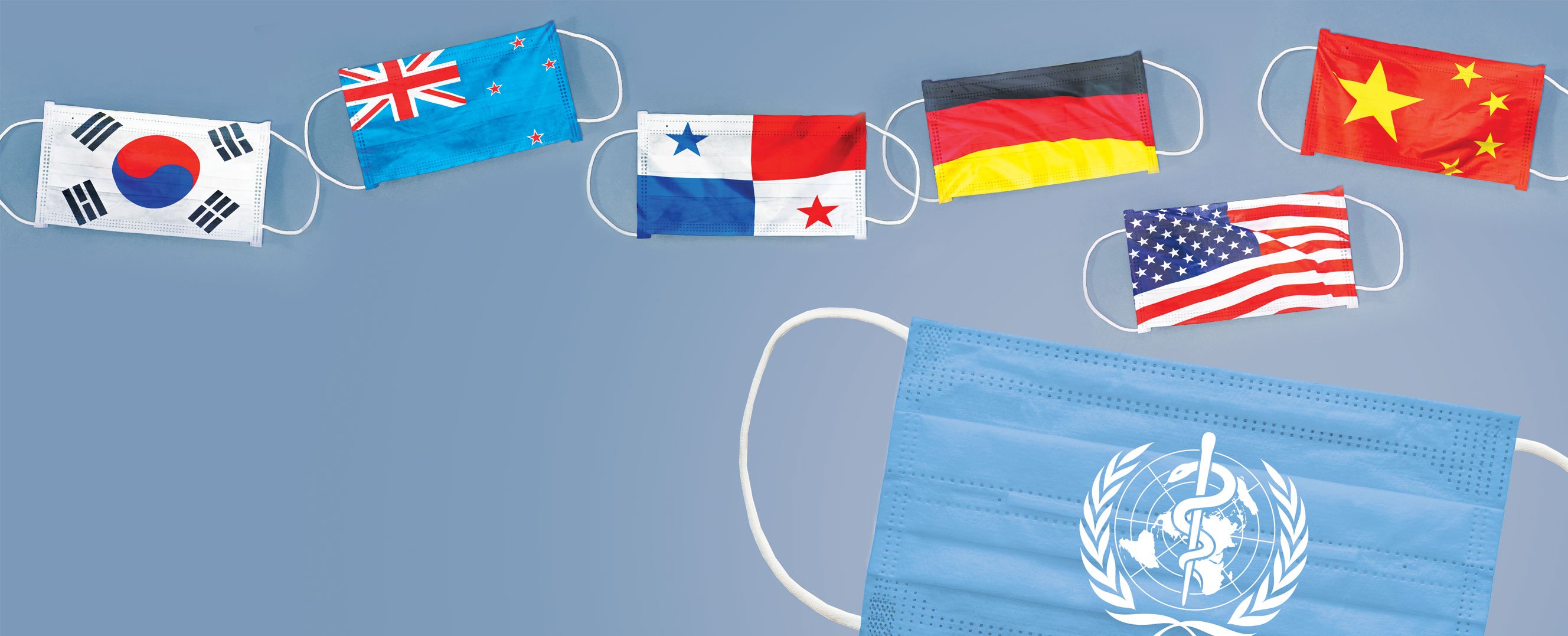As countries’ first line of defense against a crisis, health systems need to be strengthened
Millions of infections, hundreds of thousands of deaths, and widespread lockdowns. In just six months, the COVID-19 pandemic has changed our world dramatically. As we adapt, we are learning about the virus—especially the possibility that transient immunity could expose people to waves of the virus—and about long-term effects on the lungs, heart, kidneys, and brain among those who recover.
Despite these unknowns, COVID-19 has exposed several well-known and deeply persisting inequalities. People with comorbidities such as cardiovascular and respiratory disease and diabetes are at a higher risk of complications from COVID-19, and these risk factors disproportionately affect those who are socioeconomically disadvantaged.
Women bear the brunt of caring for the sick and children, are at high risk of domestic violence during quarantines and lockdowns, and are affected by disruptions in access to sexual and reproductive health services, as well as by job losses in the informal sector.
Loading component...
This pandemic has also laid bare inequality between rich and poor countries. For the most part, rich countries have better-funded health systems and can afford to temporarily freeze their economies and inject billions of dollars into economic stimulus packages. Yet most poor countries have underfunded and inadequately staffed health systems, weak water and sanitation systems, large populations, mounting debt, colossal unemployment, and limited fiscal capacity for economic relief.
To make matters worse, another pandemic can strike at any time, even as we struggle with the current crisis. Apart from looming global pandemics, there is also the threat of extreme weather events and natural disasters, as well as recurring economic crises, all of which have devastating effects on communities and health systems.
During all of these natural and human-caused crises, it is a country’s health system that is the first line of defense, and if the system is not resilient, it will be overwhelmed and collapse, exacerbating the health impact and adding to inequality. Countries such as Germany, New Zealand, South Korea, Taiwan Province of China, and Vietnam—all of which have managed to control COVID-19 better than others—have demonstrated resilience in their health systems.
Resilient health systems
Harvard public health professor Margaret Kruk defines health system resilience as “the capacity of health actors, institutions, and populations to prepare for and effectively respond to crises; maintain core functions when a crisis hits; and, informed by lessons learned during the crisis, reorganize if conditions require it” (Kruk and others 2015). In the face of a crisis, a resilient health system can cope with the shock, continue to provide services, and return to normal functioning once the crisis settles, thereby delivering positive health outcomes in both good and bad times.
However, a health system does not function in a silo; it operates within a socioeconomic and political context, clearly reflected by the direct and indirect health effects of pandemics and other shocks on vulnerable populations. A resilient post–COVID-19 health system must also address these vulnerabilities and inequalities and sustainably respond to a range of crises in the future.
Based on the growing literature and country experiences of Ebola and COVID-19, we can outline five broad features of a resilient national health system.
First, it must be vigilant. Countries must strengthen their existing disease surveillance systems to routinely collect and analyze information across public and private health care in order to prevent or quell outbreaks. Several simple and effective disease surveillance systems have been developed and adapted in low-resource settings. For instance, in the early 1980s, virologist T. Jacob John established a novel system in south India using a standardized set of symptoms (which would today be called “syndromic surveillance”) to detect and limit disease outbreaks (John and others 1998). This national surveillance system must also incrementally build its capacity to routinely monitor such events in neighboring countries and regions and worldwide, which requires capacity building as well as diplomacy.
Second, it must be responsive. Early response is a defining feature of the health systems of Germany, New Zealand, South Korea, and Taiwan Province of China, as well as in states such as Kerala in India—all of which have managed to control COVID-19 effectively. Responsiveness calls for preparedness, which can take years of planning and investment, long before a pandemic hits. Singapore and Taiwan Province of China responded to the deadly 2003 SARS outbreak with elaborate response plans and annual drills in hospitals, while in South Korea, following the 2015 MERS outbreak, the government invested heavily in standard operating protocols and incentivized its biomedical companies to research and develop rapid diagnostic tools. Countries may have emergency preparedness plans and protocols, but these need to be aligned with dedicated individuals and teams with decision-making autonomy to respond swiftly, as well as with investment to strengthen the health infrastructure and a workforce and procedures for emergency procurement and replenishment in the event of shortages.
Third, it must be flexible and adaptable. Hospital staff in several countries have been redeployed to COVID-19 wards. In January and February, nearly 3,000 health workers in Cambodia were trained and deployed to implement rapid detection and contact tracing. In China, Fangcang shelter hospitals were rapidly set up in February 2020—large-scale venues such as stadiums and exhibition centers were converted to temporary hospitals to isolate and care for people with mild to moderate COVID-19 symptoms and reduce the burden on hospitals. Across the world, hospitals have shifted some of their health services to virtual forums such as telephone and video consultations. Such practices show the potential of flexible use of existing resources—whether the workforce or health care facilities—and adaptation to a rapidly changing situation.
Fourth, it is only as resilient as the communities it serves. District public health teams must engage and involve local leaders and community volunteers in structured roles during emergencies; extension of roles during normal times could enhance participatory governance. In Thailand, more than 1 million village health volunteers have monitored communities for COVID-19. In Kerala more the 300,000 youth volunteers were trained and deployed by the government to deliver social services to local communities during the lockdown and support quarantined households (WHO 2020). Local leaders and volunteers are trusted in their communities, and when district health teams partner with such stakeholders it can ensure two-way communication and persuade communities to adopt recommended behavior.
Fifth, and most important, resilient health systems must be equitable. People in both rich and poor countries without effective health coverage have struggled to get tested and seek timely treatment for COVID-19 and other health emergencies. Universal health coverage, regardless of socioeconomic status, geographic location, gender, age, or preexisting conditions, is needed now more than ever (WHO 2010). Countries must invest in universal health coverage, particularly by expanding health insurance coverage and strengthening primary health care services, to ensure early detection and response to COVID-19 and other infectious diseases. This will prevent secondary and tertiary health facilities from being overburdened and disrupting the delivery of other essential health services. Most important, universal health coverage will keep families from falling into poverty during such public health emergencies.
Loading component...
Govenments will also have to strengthen three cross-cutting areas to ensure health system resilience. First, a multisectoral government approach is urgently needed, whereby mechanisms are built and activated for health policymakers to work closely with their counterparts in other relevant public sectors, including education, social welfare, finance and trade, and the environment.
Partnership with the private health sector is the second cross-cutting task. In several low- and middle-income countries, private facilities are the first health care contact point and deliver the bulk of services. This sector cannot be ignored and must be sustainably engaged under public stewardship.
Third, clear, consistent, transparent, and timely communication is needed through various channels, including credible voices for both internal (public sector departments) and external (public) audiences. These communication channels must include and incorporate feedback. Good communication will build public trust in government and encourage adherence to the behavior needed to disrupt transmission and control outbreaks.
Making it happen
Financing is critical to achieving the above features in cross-cutting areas of health system resilience. Governments must increase domestic financial resources for the public health system through mechanisms such as budget reallocation, tax reform and management, and luxury and sin taxes as well as collaboration with the private and philanthropic sectors. In 2013, within one year of introducing sin taxes on alcohol and tobacco, the Philippines generated $1.2 billion, which made it possible to enroll an additional 45 million citizens in universal health coverage.
Governments can also make a substantial difference by reducing inefficiencies in their health spending. This can be achieved through strategies such as reforming incentive and payment structures to address overuse of services, controlling excessive markups on medicines and promoting generics, pooled medicine purchases, and addressing corruption.
Poorer countries suffering from economic shocks will have a hard time raising money for domestic health financing, which is why we urgently need a coordinated global response. Richer countries, donors, and multilateral agencies must step up development assistance. Institutions such as the World Bank and the IMF have taken initial steps with increased emergency financing, debt relief, and support for debt service suspension. Future support beyond unconditional emergency financing should support broad health system strengthening and resilience and protect social spending and safety nets for the most vulnerable.
Governance holds the key to an effective response for resilient health systems in the face of COVID-19 and future public health emergencies. Effective governance calls for committed leadership across political parties and structures that reflect accountability and transparency, as well as mechanisms for decision-making autonomy and incentives for public health officials across all levels of government.
Worldwide commitment to cooperation on COVID-19 vaccines and therapies starts with collective support for the World Health Organization (WHO). Despite its shortcomings, no other international agency has the technical, normative, and convening capacity to bring countries together at the same table for ensuring equitable access to global public goods for public health emergencies. With the recent US announcement to withdraw from the WHO and threats to overall funding, international cooperation, as demonstrated at the World Health Assembly in May 2020, is more relevant than ever (Sridhar and King 2020).
As former Liberian President Ellen Johnson Sirleaf said, “Coronavirus anywhere is a threat to people everywhere.” No government can completely resolve the COVID-19 crisis alone; it takes global cooperation and solidarity.
Opinions expressed in articles and other materials are those of the authors; they do not necessarily reflect IMF policy.
References:
John, T. J., R. Samuel, V. Balraj, and R. John. 1998. “Disease Surveillance at District Level: A Model for Developing Countries.” Lancet 352 (9121): 58–61.
Kruk, M. E., M. Myers, S. T. Varpilah, and B. T. Dahn. 2015. “What Is a Resilient Health System? Lessons from Ebola.” Lancet 385 (9980): 1910–12.
Sridhar, D., and L. King. 2020. “US Decision to Pull out of World Health Organization.” BMJ 370:m2943.
World Health Organization (WHO). 2010. “Health Systems Financing: The Path to Universal Coverage.” Geneva.
———. 2020. “Responding to COVID-19—Learnings from Kerala.” Geneva.








